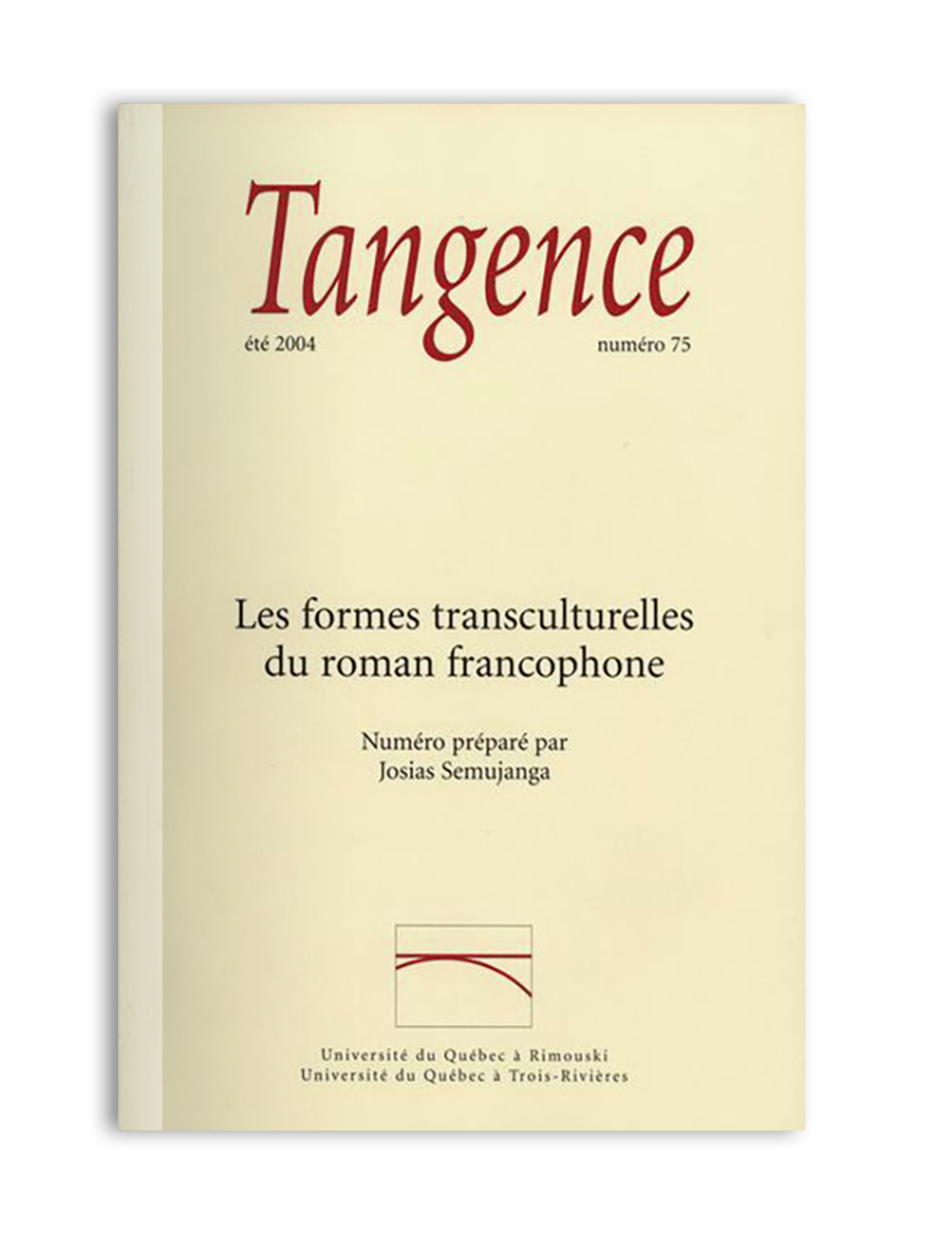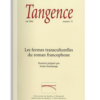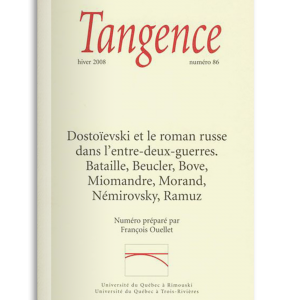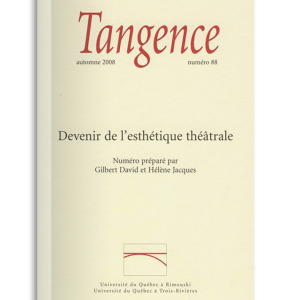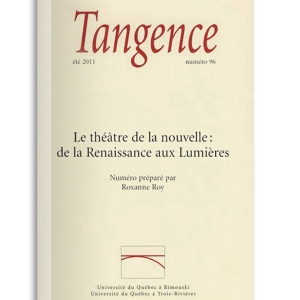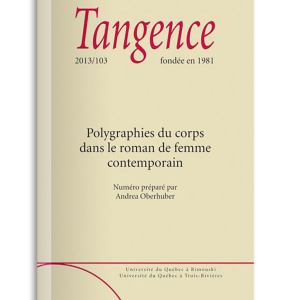N° 75, été 2004
Les formes transculturelles du roman francophone
Josias Semujanga
La mémoire transculturelle comme fondement du sujet africain chez Mudimbe et Ngal
Dans les œuvres de fiction, la ligne de démarcation entre les notions de mémoire et d’histoire est devenue difficile à tracer puisque la fiction conjoint ce que le discours savant sépare dans les représentations du passé. Est-ce la mémoire qui emprunte la voie de l’histoire pour transmettre l’événement ? Est-ce au contraire le discours historique qui repose sur les fragments d’un événement déjà érigés en mémoire ? Quelle que soit la réponse à ces questions, on se trouve confronté à un problème complexe : celui d’un récit construisant le sens d’un événement passé. À cet égard, les œuvres africaines sont exemplaires, car elles retravaillent ces questions de la mémoire et de l’oubli de l’événement fondateur qu’est la colonisation en révélant une vision transculturelle qui, tout en manifestant inlassablement la hantise de cet événement, tente de dépasser le piège du jeu de miroirs. Comprise comme opération transformatrice, l’écriture surgit au moment de la traversée simultanée de plusieurs cultures, la transculture devenant ici un lieu neutre où sont convoquées diverses représentations du monde, comme en témoignent les textes de Mudimbe et de Ngal sur lesquels cette réflexion s’appuie.
Transcultural Memory as Foundation of the African Subject in Mudimbe and Ngal
In works of fiction, the line of demarcation between the notions of memory and history has become difficult to trace, since fiction joins together what scholarly discourse separates in representations of the past. Is it memory that borrows the path of history to transmit the event ? Or, on the contrary, is it historical discourse that rests on the fragments of an event already erected in memory ? Whatever the answer to these questions, we find ourselves confronted with a complex problem — that of a narrative constructing meaning from a past event. African works are exemplary in this respect, since they rework these issues of the memory and forgetfulness of the founding event — colonization — by revealing a transcultural vision that, while tirelessly manifesting an obsession with this event, attempts to avoid the trap of getting lost in the mirror. Understood as a transformative operation, writing springs up at the moment of the simultaneous crossover of many cultures, transculture becoming here a neutral place where various representations of the world are summoned, as seen in the texts of Mudimbe and Ngal, on which this idea is based.
***
Alexie Tcheuyap et Étienne-Marie Lassi
Réécriture filmique et discours sur l’immigration. Le gone du Chaâba d’Azouz Begag et de Christophe Ruggia
Le gone du Chaâba d’Azouz Begag illustre la difficile cohabitation entre les immigrants maghrébins en France et leur communauté d’accueil. Onze ans après sa publication, Christophe Ruggia réalise une version filmique du roman, déplaçant ainsi du livre à l’écran la problématique de l’immigration. Cet article, qui s’intéresse aux modalités esthétiques et discursives de cette réécriture, identifie et analyse quelques mutations textuelles significatives afin de déterminer quels suppléments de sens différentiels elles apportent au texte tuteur dont l’altération semble inévitable dès que se met en marche le procès de la reprise. Ces diverses transformations, opérées souvent sous le mode de l’hypertrophie, permettent de reformuler le discours romanesque sur l’identité et les trajectoires sociales des populations immigrées.
A Film Rewriting and Discourse on Immigration. Le gone du Chaâba by Azouz Begag and Christophe Ruggia
Le gone du Chaâba by Azouz Begag depicts the uneasy cohabitation between Maghrebian immigrants in France and the host community. Eleven years after its publication, Christophe Ruggia made a film version of the novel, thereby shifting the issue of immigration from book to screen. This article, which focuses on the aesthetic and discursive modalities of this rewriting, identifies and analyzes a few significant textual mutations in order to determine what additional differential meanings they contribute to the tutor-text, whose alteration appears inevitable once the process of reworking has been set in motion. These various transformations, often operating through a kind of hypertrophia, make it possible to reformulate fictional discourse on the identity and social trajectories of immigrant populations.
***
Justin Bisanswa
Figures et spectres
Quel rapport le roman africain entretient-il avec le réalisme ? Afin de mettre en évidence la richesse et la multiplicité des formes romanesques, cet article entend montrer que le rapport mimétique que les écrivains africains croyaient cultiver avec le monde était en partie illusoire et que leur prétention à la transparence masquait les ruses et les procédés d’une rhétorique. Que le roman africain ne soit pas aussi mimétique que le prétend une certaine critique ne l’empêche pas de nous en dire beaucoup sur une réalité toujours ancrée dans l’Histoire et de tenter d’en cerner la vérité. Quand il va jusqu’au bout de ce qui le meut, il est un instrument hors pair d’analyse des rouages et des mécanismes sociaux. Là où le roman africain réussit le mieux à nous dire la vérité du social, c’est à même le romanesque, à même son imaginaire, à même son écriture ou sa poétique.
Figures and Ghosts
What is the African novel’s relationship to realism ? To highlight the richness and multiplicity of fictional forms, this article aims to show that the mimetic relationship African writers believed they developed with the world was in part illusory, and that their pretence of transparency masked the tricks and processes of rhetoric. The fact that the African novel is not as mimetic as a certain critical thought would have us believe does not prevent it from telling us much about a reality still anchored in History, and from attempting to define the truth of it. When it reaches to the edge of what drives it, it is an unparalleled instrument for analyzing social cogs and mechanisms. Where the African novel succeeds best in revealing social truth is in its fictional universe, in its imagination, in its writing or its poetics.
***
Sélom Komlan Gbanou
Le fragmentaire dans le roman francophone africain
Au centre des constellations esthétiques dans le roman africain d’expression française est apparue, ces deux dernières décennies, une forme particulière d’écriture qui rompt d’avec le récit-fleuve, linéairement compact des écrivains de la première génération. L’écriture participe désormais d’un travail de plus en plus conscient d’invention et d’intervention tant sur le langage que sur le corps du projet romanesque pour aboutir à un ensemble hétérogène, à la limite hétéroclite, qui échappe à la forme classique du roman. Les transformations annoncées par des auteurs comme Ahmadou Kourouma, Mohamed-Alioum Fantouré ou Henri Lopes se poursuivent avec bonheur chez les écrivains de la postcolonie (Sami Tchak, Kossi Efoui, Abdouhraman Wabéri, etc.), surtout en situation d’exil, et donnent à penser que le romanesque cherche à souscrire aux différents fantasmes et soubresauts qui remuent la conscience des exilés/migrants ou, à l’inverse, veut tirer profit de l’esthétique postmoderne de l’éclatement, de l’émiettement et du chaos découvert dans le nouveau rapport au monde favorisé par la mondialisation. Chez un grand nombre d’écrivains, l’écriture devient un exercice de sclérose de la forme et est entièrement absorbée par le goût et, peut-être même, l’obsession de la fragmentation, du chaos, du micmac et du non-sens de la vie.
The Fragmentary in the French African Novel
At the heart of the aesthetic constellations in French African fiction, a particular form of writing has appeared during the last two decades that breaks with the compact, linear récit-fleuve of first-generation writers. Henceforth, writing is characterized by work that is increasingly conscious of invention and intervention as regards both language and the body of fiction, resulting in a heterogeneous — even eccentric — entity that escapes the classic form of the novel. The transformations heralded by authors such as Ahmadou Kourouma, Mohamed-Alioum Fantouré or Henri Lopes fortunately continue in post-colonial writers (Sami Tchak, Kossi Efoui, Abdouhraman Wabéri, etc.), particularly in a situation of exile, giving the idea that fiction seeks to subscribe to the various fantasies and shocks that excite the conscience of exiles/migrants or, conversely, wishes to take advantage of the postmodern aesthetic of rupture, crumbling and chaos discovered in the new relationship to the world fostered by globalization. In a large number of writers, writing becomes an exercise in sclerosis of form and is entirely absorbed by a taste for — and perhaps even an obsession with — fragmentation, chaos, intrigue and the nonsense of life.
***
Christiane Ndiaye
Le dépassement de la discrimination des formes : métissages intertextuels et transculturels chez Pineau, Sow Fall et Mokeddem
Plusieurs textes des écrivaines de la francophonie interrogent de diverses manières les formes littéraires canoniques. Cet article examine le questionnement des genres et textes fondateurs dans trois romans qui procèdent à un décloisonnement interculturel et transgénérique. Dans L’espérance-macadam de Gisèle Pineau, c’est l’usage inapproprié du texte biblique et des contes merveilleux (« contes bleus ») qui est problématisé à travers des personnages qui n’ont plus de langage propre à force de reproduire fidèlement ces modèles consacrés. Chez Aminata Sow Fall, le romanesque fusionne avec la forme traditionnelle de l’épopée pour créer un métadiscours qui valorise la multiplicité des formes et des lectures et récuse toute hiérarchie qui instaure une discrimination entre formes (races ou individus) « supérieures » et « inférieures ». Ce principe de l’égalité des races, cultures et formes littéraires se trouve également au centre du roman de Malika Mokeddem, Le siècle des sauterelles, où l’Orient rencontre l’Occident, où oralité et écriture, poésie et histoire s’amalgament dans un métissage textuel éloquent. Ainsi, ces romancières ne se contentent pas de raconter des histoires plaisantes ; elles mettent en évidence l’un des fonctionnements essentiels de la littérature contemporaine, déjà conceptualisé par Glissant : relater, c’est-à-dire raconter mais aussi mettre en relation.
Beyond Form Discrimination : Intertextual and Transcultural Miscegenation in Pineau, Sow Fall and Mokeddem
Many texts by women writing in French question canonical literary forms in a variety of ways. This article examines the investigation of basic genres and texts in three novels that proceed to an intercultural and transgeneric decompartmentalization. In L’espérance-macadam, Gisèle Pineau calls into question the inappropriate use of the Bible and fairy tales (contes bleus) through characters who have so faithfully reproduced these time-honoured models they no longer have their own language. In Aminata Sow Fall, fiction merges with the traditional form of the time to create a metadiscourse that enhances the multiplicity of forms and readings and objects to any hierarchy establishing a discrimination between « superior » and « inferior » forms (races or individuals). This principle of the equality of races, cultures and literary forms is also found at the heart of a novel by Malika Mokeddem, Le siècle des sauterelles, where East meets West, where the spoken and written word, poetry and history mingle in an eloquent textual miscegenation. Thus, these female novelists do not content themselves with telling pleasant stories ; instead, they highlight one of the essential functions of contemporary literature, already conceptualized by Glissant — relating, that is, recounting but also placing in relationship.
***
Isaac Bazié
Roman francophone : écriture, transitivité, lieu
Le roman francophone peut se lire comme un discours tantôt dichotomique et tantôt éclaté, et s’il met en scène aussi bien des problèmes d’ordre esthétique qu’éthique, il peut aussi bien être l’objet de sa propre mise en scène. Cet article propose une lecture du roman africain qui cherche à penser ensemble écriture et représentation du corps. À partir de l’allégorie du corps prisonnier dans Le vieux nègre et la médaille de Ferdinand Oyono, il s’agit de lire une posture d’énonciation qui s’apparente à une prise de conscience susceptible de s’ouvrir sur une appropriation créatrice de nouvelles manières de (se) dire. Cette lecture critique des enjeux du texte romanesque, qui s’intéresse notamment à des notions comme celles de « corps figuré » et, par suite, « figurant », s’attarde aux modèles de lecture des écritures francophones, de manière à dégager un lieu qui soit le support d’un discours romanesque transculturel et éclaté.
The French-language Novel : Writing, Transitivity, Place
The French-language novel may be read as a discourse that is sometimes dichotomous, sometimes fragmented, and if it highlights aesthetic as well as ethical problems, it may just as well be the object of its own presentation. This article proposes a reading of the African novel that seeks to view together writing and the representation of the body. Beginning with the allegory of the imprisoned body in Le vieux nègre et la médaille by Ferdinand Oyono, the point is to read a posture of enunciation resembling an awareness that may open the path to a creative appropriation of new ways of speaking, and of speaking of oneself. This critical reading of the issues in the text of a novel, which focuses notably on such notions as corps figuré and, consequently, figurant, focuses on models for reading French language writings, so as to draw out a place that will provide support for a transcultural and fragmented fictional discourse.

